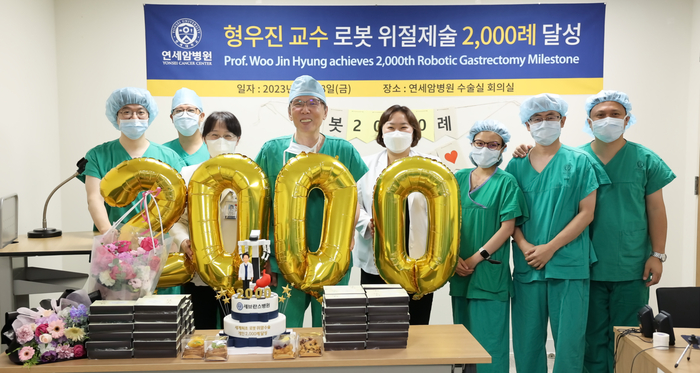RELATED Live

Professor Hyeong Woo-jin has successfully completed the world's first 2,000th robotic surgery for gastric cancer.
On the 18th, Professor Hyeong successfully performed robotic surgery on Mr. Choi (58 years old, male), marking the 2,000th surgery since he first began robotic surgeries on gastric cancer patients in 2005.
According to the National Cancer Information Center's 2020 statistics on the "Most Commonly Diagnosed Cancers," gastric cancer ranked fourth, accounting for 10.8%. In Korea, 30,000 individuals are diagnosed with gastric cancer annually, a rate ten times higher than in the U.S. per 100,000 people.
Gastric cancer treatments include surgery, chemotherapy, and other options. Early-stage gastric cancers often undergo minimally invasive procedures such as endoscopic resection; however, gastrectomy combined with chemotherapy is sometimes used for advanced stages. Laparoscopic surgery involves making 2-3 incisions, each about 10 mm in length, in the abdomen of advanced gastric cancer patients and inserting an endoscopic tool equipped with a camera. Recent technological advancements have popularized robotic surgery, which employs a thin 8 mm robotic arm capable of 360-degree rotation. This approach minimizes the incision size, reducing patient discomfort, and the 360-degree rotating robotic arm also simplifies the surgery.
Professor Hyeong has further enhanced the precision of such robotic surgeries. He developed a surgical navigation system that learns from the patient's CT (computed tomography) scans and automatically creates 3D graphics. This digitally renders the patient's organs and surrounding vascular distribution, allowing for a more customized robotic surgery. The precision and reliability of this technology have been proven through clinical trials, and it can even detect blood vessels as thin as 1 mm in diameter with 100% accuracy. In addition, he introduced fluorescence-guided gastrectomy, in which a fluorescent substance is injected into the submucosal layer of the stomach using an endoscope. This visualizes the tumor location, metastatic routes, and other details, providing a surgical reference.
Professor Hyeong Woo-jin remarked, "Since introducing robotic surgery as the latest technique, I've worked to enhance its maturation by developing surgical navigation and fluorescence-guided gastrectomy." He added, "I am committed to conducting more intricate surgeries by integrating my clinical experiences and research to develop these techniques."
Inquiry